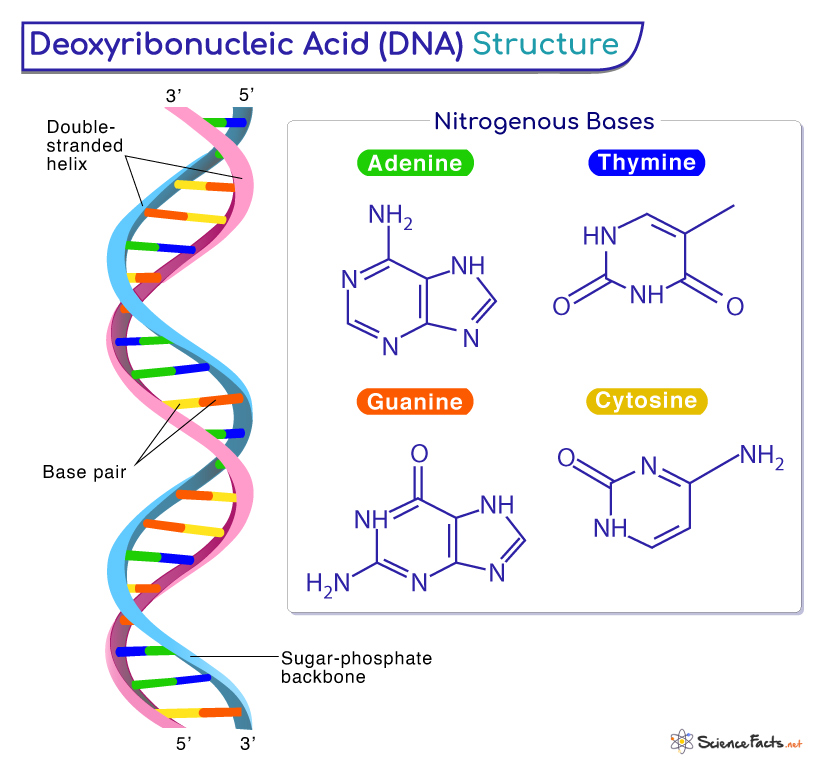Within a eukaryotic cell (plant and animal), they are found inside the nucleus, distributed among its chromosomes. Chromosomes consist of thousands of short DNA segments called genes. In contrast, DNA is located within a central dense area called the nucleoid in a prokaryotic cell like bacteria. Since DNA reside inside the cell, it is too small to be seen with the naked eye. They are visible only under an electron microscope. Some organisms have ribonucleic acid (RNA) instead of DNA as their genetic material.
Who Discovered DNA and When Was It Discovered
What is DNA Made Of
What is the Chemical Structure of DNA
What is the Function of DNA
The 5’ carbon of one nucleotide is connected to the 3’ carbon of another nucleotide by phosphodiester bonds. There is a covalent bonding between the oxygen of the 3’ carbon of the first nucleotide and the phosphorous in the phosphate group of the 5’ carbon of the second nucleotide. Thus, these are called 3’-5’ phosphodiester bonds. During the polymerization of DNA, when a new nucleotide is added, a water molecule is lost through dehydration synthesis. The two strands run in opposite directions, known as antiparallel orientation. One strand has a 5’ end with a free phosphate group and a 3’ end with a free hydroxyl group (-OH). The other strand is oriented in the opposite direction having its 5’ end facing the 3’ end of the first strand and vice versa.
Characteristics of a DNA Strand
Some critical features of a DNA strand are:
Complementary Base Pairing: The nitrogenous bases in DNA form pairs through noncovalent hydrogen bonding, ensuring specificity in base pairing. Adenine (A) always pairs with thymine (T) through two hydrogen bonds, while cytosine (C) always pairs with guanine (G) through three hydrogen bonds. This complementary base pairing is the foundation of DNA’s ability to replicate accurately and transmit genetic information. According to Erwin Chargaff, the ratios of adenine (A) to thymine (T) and guanine (G) to cytosine (C) are equal.Base Stacking: The flat, planar structure of the nitrogenous bases allows them to stack on top of each other within the double helix. This base-stacking interaction stabilizes the DNA molecule and contributes to its structure and shape.Major and Minor Grooves: The base pairing along the helix forms grooves on the surface of the DNA double helix. These grooves are known as the major groove and the minor groove. They are critical in interactions with proteins that bind to specific DNA sequences and regulate cellular processes.
Store and Transmit Genetic Information (Inheritance)
The primary function of DNA is to store and transmit genetic information from a parent cell to a daughter cell. DNA contains the instructions that determine an organism’s characteristics, such as its physical traits, behavior, and metabolic processes. These genetic instructions are passed from parents to offspring during reproduction, ensuring species continuity and trait inheritance.
Helps to Synthesize Proteins
One of the most crucial functions of DNA is its role in protein synthesis. Proteins are essential molecules that perform various functions in cells and organisms. DNA serves as a template for synthesizing proteins through a two-step process: transcription and translation. During transcription, a segment of DNA is transcribed into a molecule called messenger RNA (mRNA) by an enzyme called RNA polymerase. The mRNA is further converted to proteins, a process called translation.
Helps to Copy DNA
Before a cell divides, it must duplicate its genetic material to ensure that each daughter cell receives an identical copy of the DNA. Copying parent cell DNA, called DNA replication, helps maintain its exact copies generation after generation.
Bringing Genetic Diversity within the Population
While DNA replication is remarkably accurate, errors can occasionally occur, leading to changes in the DNA sequence known as mutations. These mutations are the raw material for genetic diversity and evolution. Some modifications can be advantageous, offering new adaptations that confer survival benefits in specific environments. Others may be neutral or even harmful. Over time, the accumulation of beneficial mutations can drive the evolution of species, allowing them to adapt to changing conditions.
Regulating Gene Functions
Not all genes in a cell are active all the time. Instead, they are precisely regulated to respond to specific cues and signals. DNA plays a central role in gene regulation. Regulatory proteins and chemical modifications to DNA determine whether a gene is turned on or off. This regulation allows cells to differentiate into various types during development and adapt their functions to environmental changes, ensuring the coordinated operation of complex cellular processes.
